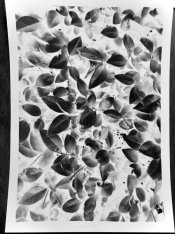Despite being kind of a sharpness whore with my normal gear, I have always had a fascination with pinhole photography.
I also find that 90% of my nature photography ends up being fairly simple and everyday subjects photographed in overcast or open shade conditions, so I develop a lot of negatives at N+1.
For the last couple of years, I've had a lot of fun designing and 3D printing custom camera and camera-related items.
Finally, I recently got into alt process printing, specifically kallitypes and salted paper.
Add these 4 things together, and you get an oddly compelling idea one day to design a 5x7 pinhole camera. 5x7 is big enough that even pinhole photos can look somewhat detailed. It's big enough to make contact prints worth displaying. It's just small enough to barely fit in my 3D printer's limited space. And paper negatives will give me a lot of contrast, without being likely to exceed the dynamic range of scenes I typically photograph. Those contrasty negatives will probably make for a pretty good salt print. It all kinda works out, at least on paper.
The "film holder" I designed is simple - a plate with a baffle that will keep light out when it's attached to the camera, a frame with embedded magnets to keep the 5x7 paper in place and give it 1/4" borders. No need to carry around multiples of them that can keep light out when not attached to the camera; my exposures will range from minutes to days. It's working as intended on the first prototype. The camera body lacks the finesse of a better 3D designer, and it's a behemoth (600g of filament). But it printed out nice and it does its job. Focal length is 150mm for a nice medium wide angle. I have a 0.4 and 0.5 laser drilled pinhole on the way from a guy in France.
Pretty excited to see what I can do with this glorified box.
I also find that 90% of my nature photography ends up being fairly simple and everyday subjects photographed in overcast or open shade conditions, so I develop a lot of negatives at N+1.
For the last couple of years, I've had a lot of fun designing and 3D printing custom camera and camera-related items.
Finally, I recently got into alt process printing, specifically kallitypes and salted paper.
Add these 4 things together, and you get an oddly compelling idea one day to design a 5x7 pinhole camera. 5x7 is big enough that even pinhole photos can look somewhat detailed. It's big enough to make contact prints worth displaying. It's just small enough to barely fit in my 3D printer's limited space. And paper negatives will give me a lot of contrast, without being likely to exceed the dynamic range of scenes I typically photograph. Those contrasty negatives will probably make for a pretty good salt print. It all kinda works out, at least on paper.
The "film holder" I designed is simple - a plate with a baffle that will keep light out when it's attached to the camera, a frame with embedded magnets to keep the 5x7 paper in place and give it 1/4" borders. No need to carry around multiples of them that can keep light out when not attached to the camera; my exposures will range from minutes to days. It's working as intended on the first prototype. The camera body lacks the finesse of a better 3D designer, and it's a behemoth (600g of filament). But it printed out nice and it does its job. Focal length is 150mm for a nice medium wide angle. I have a 0.4 and 0.5 laser drilled pinhole on the way from a guy in France.
Pretty excited to see what I can do with this glorified box.





 A roughly 35mm equivalent focal length is working out dandy.
A roughly 35mm equivalent focal length is working out dandy.